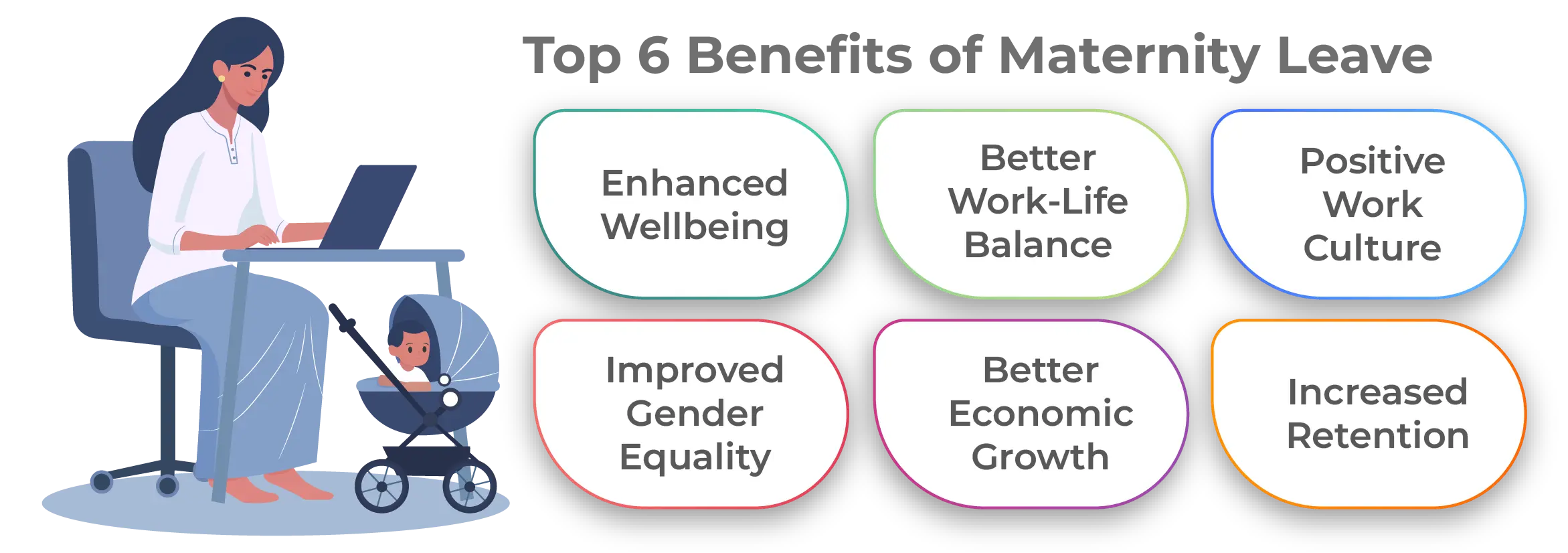
Maternity Leave: Meaning, Policy & Rules
Table of Contents

Reading Time: 10 minutes
Motherhood is a miracle of nature and everyone has the right to experience it, even if they are employed with an organization. On 23rd May 2025, the Supreme Court of India ruled that, “Maternity leave is integral to maternity benefits. Reproductive rights are now recognized as part of several intersecting domains of international human rights law, viz. the right to health, right to privacy, right to equality and non-discrimination and the right to dignity.”
Being a secular and progressive nation, India has always been a staunch protector of human rights, as is evident from the fact that we established the Maternity Benefit Act in 1961! The Supreme Court’s ruling highlights a fundamental aspect of motherhood: it is a basic human right of any individual.
Hence, let us try to understand this Act and its benefits for female employees who wish to experience a beautiful part of Life: Motherhood.
What is Maternity Leave?
Maternity Leave is the leave granted to female employees of an organization to take care of their pregnancy, as well as the newborn after birth. It one of the most important types of leave as it is also applicable in cases where a child is adopted, as the maternity leave helps the mother bond with their child.
It also helps the mother in recuperating from childbirth, as well as helping her recover from postpartum stress. Since it is a time of physical, emotional, and physiological changes in the mother, maternity leave acts as the ideal time for them to rest as well as take care of their newborn.
What is the Maternity Leave Policy in India?
The maternity leave policy helps expecting mothers to take long-term leave from their organization to take rest through, as well as, after their pregnancy. It is mandated by the Government, and hence, organizations are bound to provide the same to their female employees, which they can convey through their employee leave management system.
Following are some of the relevant points to remember about the maternity leave policy in India:
- Female employees are entitled to the maternity leave of 26 weeks for their 1st and 2nd child. They can take leaves up to 8 weeks before their delivery.
- Similarly, they are entitled to maternity leave of 12 weeks for their 3rd and 4th child.
- Additionally, a mother who is adopting a child is also eligible for a maternity leave of 12 weeks, which starts from the day the child is handed over to them.
- The law also has a provision for cases of miscarriage, which requires the company to provide 12-week maternity leave. However, she should provide medical proof of the miscarriage.
Failure to abide by the rules and regulations of the maternity leave policies attracts hefty fines, as well as imprisonment, depending on the severity of the case.
Following are the major details of the Official Maternity Leave Policy in India:
1. Maternity Benefit Act 1961
The Maternity Benefit Act of 1961 was the 1st attempt at regulating the maternity leave policies in the country. It provided mothers with maternity benefits, medical bonuses, paid leave, and more to ensure the well-being of the mother and the baby. Additionally, it covers the period from pregnancy to birth to even a few weeks after the birth to safeguard the interests of the new mother.
2. Maternity Benefit Act 2017
The Maternity Benefit Act of 1961 has been updated multiple times to keep the provisions of the Act up to date according to the times. However, in 2017, major amendments were undertaken to increase the duration of maternity leave, including adopting mothers as well as commissioning mothers within the benefits of the Act, as well as the provision to work from home if required.
3. Right to Pay
The ‘Right to Pay’ is one of the most crucial aspects of the Maternity Act as it ensures that female employees are paid during their maternity leaves. It helps the female to avoid any financial struggles due to their pregnancy.
Following are some of the key aspects of the ‘Right to Pay’:
➔ Entitlement
Any female employee who is eligible for maternity leave in India will also be eligible for the ‘Right to Pay’. They will be receiving this compensation from their employer, whether this employer is private or the government.
➔ Rate of Pay
The rate of payment of wages would be a portion of the average daily wage of the employee before their maternity leave. It is often decided to be a specific percentage of their actual daily wages.
➔ Legal Mandate
Employers are required to abide by the Maternity Act, and the failure to do so will result in either imprisonment or fines for the employer. However, the duration of imprisonment and the amount of the fine will depend on what the employer does. For example, they may decide to simply not pay the employee who is taking maternity leave, or they may even terminate her employment with the organization. The consequences in both cases will be different due to the difference in the severity of the issue.
Maternity Leave Rules
Maternity leave rules in India provide multiple benefits to female employees, such as:
- Organizations are required to pay complete salaries to their female employees during their maternity leave.
- The salary provided during this period should be calculated according to the employee’s daily wages during the 3 months before the leave.
- Businesses should not employ a female up to 6 weeks following her delivery, miscarriage, or any kind of medical issues related to pregnancy.
- Companies are required to provide childcare facilities as well as reinstate the female employee to their initial position once they return from their maternity leave.
- Additionally, pregnant women are entitled to the following amenities in their workplace:
➔ Comfortable working arrangements
➔ Clean drinking water
➔ Hygienic Restrooms, etc.
- Similarly, employers should refrain from allocating physically and mentally draining tasks to pregnant women 10 weeks before the expected delivery date.
- Employers can also provide additional leaves to new mothers if they are unable to return to work after their delivery due to any reasons. However, both the employee and the employer should agree upon the same beforehand. Conversely, they can also grant work-from-home options to mothers through mutual agreement.
- Additionally, employers cannot fire an employee during their maternity leave duration.
Maternity Leave Eligibility
Female employees are eligible for maternity leaves if they fulfil the following criteria:
- They have worked with an organization for at least 80 days within a year before the delivery date.
- If the employee is adopting a child younger than 3 months of age, then they are eligible for 12 weeks of paid maternity leave.
- If an employee has commissioned another woman to conceive on her behalf, she is eligible for 26 weeks of paid maternity leave.
- If an employee is acting as a surrogate mother for another person, she is eligible for 12 weeks of paid maternity leave.
- If an employee is undergoing a tubectomy, she is eligible for 2 weeks of paid maternity leave.
- If the employee is having any post-partum health issues, she is eligible for 4 weeks of extra paid maternity leave.
Maternity Leave Benefits
There are various benefits of implementing a maternity leave policy by deploying a dedicated leave management system in your organization:

1. Enhanced Wellbeing
The most important benefit of the maternity leave policy is the improved well-being of the mother and the child as they get more time together. It is especially crucial during the initial weeks after childbirth, as it helps develop the bond between the child and the mother. Similarly, since maternity leave is taken during pregnancy, it reduces the physical and mental strain on the mother by allowing them to completely concentrate on their body and the child.
2. Better Work-Life Balance
Since maternity leave policies also consider the mental stress on the mother and restrict companies from allocating stressful tasks to the employee during their pregnancy, it helps improve their work-life balance. Combined with the leaves provided, it provides the mother adequate time to adjust to the changes to her mind and body during the pregnancy phase, as well as change her lifestyle to accommodate the changes with a child.
3. Positive Work Culture
Maternity leave policies help the employees realize their importance to the organization. It helps them understand that they are valued as assets, and hence, their work-life balance is important for the company. As a result, employees remain engaged, creating a positive work environment. It helps them stay loyal to their organization, as their job security is taken care of by the maternity policies, which can be accessed from their ESS portal.
4. Improved Gender Equality
Since women are naturally evolved to take care of infants, maternity leave policies help them fulfil the role of a mother, at least during the initial years of their child. It helps them fulfil their duties as a mother without risking financial stability. Hence, maternity leaves are one of the best options to promote gender equality in the workplace.
5. Better Economic Growth
Maternity leaves provide financial stability to the mothers through their stressful period of pregnancy and childbirth. It ensures that the health of the mothers and the newborns are good, by helping them avoid work stress. All these factors motivate females to remain a robust part of the workforce, promoting economic growth.
6. Increased Retention
Additionally, the employees of an organization can understand that their company values their employees and considers them an asset, through the implementation of robust maternity leave policies. It improves the engagement rate of the staff members and helps them stay longer with their company. Hence, maternity leaves also result in improved retention rates within organizations.
Maternity Leave Challenges
Employers are required to overcome various challenges to ensure that their employees can enjoy the benefits of maternity leave. Since these challenges might deter some organizations from providing maternity leaves to their employees, the Government has established the Maternity Benefit Act.
The following are the major challenges:
➔ Disruptions in Work
A major challenge for employers is overcoming the disruptions in work caused by the absence of employees. It becomes a huge issue for small companies, that are trying to sustain using the limited resources they have. Absence from work affects both productivity and workflows, which can put a strain on the organization.
➔ Increased Costs
Additionally, to overcome the challenge mentioned above, companies hire temporary staff, which results in increased hiring and training costs for the organization. Hence, the HR team needs to plan ahead, resulting in an increased workload. Combined with the additional cost of providing salaries to non-working employees on maternity leave, it becomes a financial burden for organizations.
➔ Workload Redistribution
Workforce planning is another area of concern for the HR teams and the organization, as the tasks undertaken by the employees under maternity leave need to be re-allocated to some other employee. This replacement should be able to undertake the tasks with the same efficiency to ensure effective productivity numbers; hence, finding a suitable replacement becomes a challenge for the company.
➔ Compliance Issues
The HR teams should also ensure adherence to the Maternity Benefit Act and other related labour laws, which protect the employees’ rights as well as safeguard their employment with the organization. However, to ensure compliance, they are required to plan their workforce and their shifts according to the provisions of the law, which becomes a challenge, especially in smaller organizations.
➔ Employee Retention
Another major challenge is employee retention as the employee under maternity leave may choose to rejoin another organization. Hence, some companies also provide additional incentives to employees who are willing to rejoin after their maternity leave. Additionally, once the employee re-joins, reintegrating them into the workforce is another issue that the HR teams should tackle.
Read More:
➔ Work Environment
While an employee informs the company of their pregnancy, their shift schedules can be adjusted to reduce their workload and ensure their well-being. However, this can create resentment in other employees if they are burdened with these responsibilities. Hence, the HR teams should ensure that adequate personnel are hired temporarily for continued productivity.
Conclusion
Maternity is a period of happiness and fulfilment for all females and their employment should not hamper this important part of their life. The maternity leave policies ensure that female staff members can provide the time and energy towards their motherhood without getting concerned about their work. Understanding and implementing the various policies of the Maternity Benefit Act not only ensures compliance with the law but also enhances the well-being efforts of the organization, resulting in increased engagement and retention.
FAQs on Maternity Leave
1. What is the Maternity Leave policy in India for private companies?
According to the Maternity Benefit Act, the maternity leave policy in India is as follows:
- Maximum of 26-week paid maternity leave for first 2 children, with a maximum of 8 weeks before expected delivery date.
- Maximum of 12-week paid maternity leave for 3rd and subsequent children, with a maximum of 6 weeks before expected delivery date.
These rules apply to companies employing 10 or more employees, including both private and government organizations.
2. What is the Maternity Leave for government employees?
Under the Maternity Benefit Act, government employees are eligible to take 26 weeks of maternity leave for their first two children. However, for subsequent children, the leave duration is reduced to 12 weeks. Similarly, a 12-week maternity leave is also provided to female employees adopting a child under 3 months of age.
3. How long is Maternity Leave in India?
The maternity leave duration in India varies based on the number of children of the employee. For the first and second child, it is 26 weeks, while for subsequent children, it is 12 weeks. Similarly, adopting mothers or surrogate mothers are also entitled to 12 weeks of leave, according to the provisions of the Maternity Benefit Act.
4. Is Maternity Leave paid?
Yes, maternity leave is a paid leave in India. Female employees are entitled to a fixed pay, which is calculated as a percentage of their average daily wage, during their leave period. Having this financial support for mothers during their time away from work enables them to take care of their newborns.
5. When should you take Maternity Leave?
In India, maternity leave can be taken from 8 weeks before the expected delivery date. The remaining 18 weeks can be taken after the delivery. However, for employees with 2 or more children, the leave can be taken 6 weeks before the expected delivery date. According to the Law, the total paid maternity leave is 26 weeks for the 1st and 2nd child, and 12 weeks for subsequent children.
6. Can Maternity Leave be extended in India?
Yes, according to the Maternity Benefit Act, maternity leave in India can be extended beyond the standard 26 weeks. The Act allows extensions in cases of illness arising from pregnancy, delivery, premature birth, or miscarriages. Additionally, employers can also grant additional leave based on mutual agreement with the employee.
7. What is the eligibility for Maternity Leave in India?
To be eligible for maternity leave in India, a female employee must have worked with their employer for at least 80 days in the 12 months preceding her expected delivery date. This eligibility applies to all working women in India, covering all industries, including the public and private sectors.







